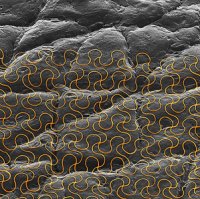 Electronic tattoo: The image shows a colorized micrograph of an ultrathin mesh electronic system mounted on a skin replica.
Electronic tattoo: The image shows a colorized micrograph of an ultrathin mesh electronic system mounted on a skin replica.
Taking advantage of recent advances in flexible electronics, researchers have devised a way to “print” devices directly onto the skin so people can wear them for an extended period while performing normal daily activities. Such systems could be used to track health and monitor healing near the skin’s surface, as in the case of surgical wounds.
Skin signals: This device, applied directly to the skin, can record useful medical information.
So-called “epidermal electronics” were demonstrated previously in research from the lab of John Rogers, a materials scientist at the University of Illinois at Urbana-Champaign; the devices consist of ultrathin electrodes, electronics, sensors, and wireless power and communication systems. In theory, they could attach to the skin and record and transmit electrophysiological measurements for medical purposes. These early versions of the technology, which were designed to be applied to a thin, soft elastomer backing, were “fine for an office environment, ” says Rogers, “but if you wanted to go swimming or take a shower they weren’t able to hold up.” Now, Rogers and his coworkers have figured out how to print the electronics right on the skin, making the device more durable and rugged.
“What we’ve found is that you don’t even need the elastomer backing, ” Rogers says. “You can use a rubber stamp to just deliver the ultrathin mesh electronics directly to the surface of the skin.” The researchers also found that they could use commercially available “spray-on bandage” products to add a thin protective layer and bond the system to the skin in a “very robust way, ” he says.
Eliminating the elastomer backing makes the device one-thirtieth as thick, and thus “more conformal to the kind of roughness that’s present naturally on the surface of the skin, ” says Rogers. It can be worn for up to two weeks before the skin’s natural exfoliation process causes it to flake off.









